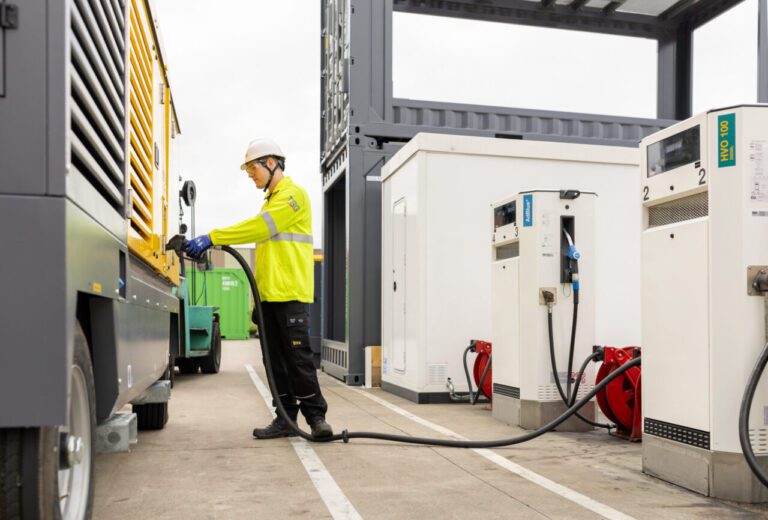
Hydrotreated Vegetable Oil (HVO) is now in use across postal, logistics, and public transport fleets, delivering up to 90% CO₂ reductions without replacing vehicles, engines or infrastructure.
HVO runs in standard diesel vehicles, moves through existing systems, and meets sustainability targets without major disruption, making it a growing part of low-emission planning for both fuel retailers and fleet operators.
But, if it’s this compatible, why hasn’t it seen broader adoption, and is that finally starting to change?
Fleet conversions already underway
Many major operators are already using HVO at scale, not as a trial, but as part of their core fleet operations.
In the UK, Michelin is converting its Stoke-on-Trent fleet to HVO, covering 50 HGVs and supporting vehicles across 3.4 million miles annually. The switch is projected to cut emissions by over 1,000 tonnes of CO₂ per year, which is around 30% of fleet emissions, and is part of Michelin’s wider plan to reach net-zero by 2050. Perth & Kinross Council is also rolling out a fleet transition with HVO and targeting a 500-tonne CO₂ reduction.
The pattern continues across Europe. Österreichische Post, the Austrian Postal Service, has fully converted its national truck fleet to run on HVO, replacing around six million litres of diesel each year. The company expects this to reduce emissions by several thousand tonnes of CO₂ annually and describes the fuel as a “bridge” until alternatives like hydrogen or e-fuels become commercially viable. The fleet operates nationwide with no engine modifications, using supply contracts that meet EU Renewable Energy Directive III (RED III) sustainability standards.
The appeal of HVO
For many operators, HVO offers a practical route to decarbonisation without disruption. It can be used in existing diesel vehicles with no need for retrofits or specialised refuelling infrastructure. In most applications, performance and fuel consumption remain identical to diesel, with substantially lower emissions.
“Fuel retailers are expected to support lower-emission alternatives, but the practical question is whether their infrastructure can handle it,” says Dan Large, Senior Product Marketing Manager at Dover Fueling Solutions® (DFS). “With HVO, the required compatibility is already in place. New Wayne and Tokheim dispensers are HVO ready, with no special updates required. Storage and monitoring systems can carry the fuel without major changes too, which is why we’re seeing it move quickly across multi-site and mixed-fleet networks.”
Availability and barriers
HVO fuel is increasingly available at public stations in many countries across Europe. In both the UK and Ireland it is available at public forecourts and truckstops as well as via distributors.
Most production relies on used cooking oil, animal fats, and other waste-derived materials – sources that meet sustainability standards, including the tightening requirements of the EU’s RED III.
Price remains a deciding factor. HVO is more expensive than conventional diesel, and for depot-supplied fleets without access to public pumps, that difference often affects procurement decisions.
Policy and production
Looking at the picture across Europe, limited access and uneven classification continue to affect HVO adoption, but policy is moving in the opposite direction. The EU’s RED III, in place since 20 November 2023, sets binding targets for all Member States: either 29% renewable energy in transport or a 14.5% reduction in greenhouse gas intensity by 2030. It also requires that 5.5% of transport energy comes from advanced biofuels or renewable fuels of non-biological origin, a category that includes HVO.
To meet these targets, production is increasing. HVO capacity in Europe was around 3.5 million tonnes in 2021 and is expected to reach 10 million tonnes by 2030.
Investment is concentrated in countries like Germany, France, Italy, the Netherlands, and Sweden, where fuel suppliers are expanding or upgrading facilities in line with national decarbonisation plans. A clear indication that policy that directly impacts demand drives investment and production.
From concept to capability
Use of HVO has demonstrated that fleets can reduce emissions quickly, without replacing vehicles or overhauling fuel networks. But scaling use across public networks and mixed fleets depends on whether infrastructure can support it consistently.
Investment by industry solutions providers such as DFS ensures that the tools to support accelerated rollout exist. As well as the company’s Wayne and Tokheim dispensers being HVO ready, for example, so are their automatic tank gauging products and wetstock management systems.
However, integration, monitoring, and cross-site compatibility remain the real test. As fuel mixes expand, so does the pressure on existing systems to manage them effectively.
“We’re seeing more sites ask whether their systems can handle not just diesel, but HVO, LNG, and whatever comes next,” says Joost Jansen, Business Development Manager at DFS. “Quality pump performance and sealing methods inherent in our dispenser design means we are ready for the rise in HVO’s popularity and for other innovations in the fuel industry.
“The infrastructure is there, now it’s all about how well it’s connected.”
Image provided by DFS